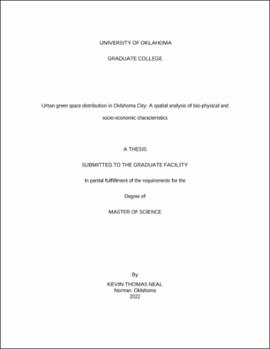| dc.contributor.advisor | Koch, Jennifer | |
| dc.contributor.author | Neal, Kevin | |
| dc.date.accessioned | 2022-05-04T20:39:49Z | |
| dc.date.available | 2022-05-04T20:39:49Z | |
| dc.date.issued | 2022 | |
| dc.identifier.uri | https://hdl.handle.net/11244/335513 | |
| dc.description.abstract | Oklahoma City, Oklahoma (OKC) is a fast-growing city undergoing urbanization.
Rapid urbanization can lead to neighborhood construction where impervious surfaces are
prioritized over urban green space (UGS). Urban green space can be defined as green
vegetation on housing parcels not just parks and recreational areas. Housing properties
are funded through banks and socio-economic status. Creating an efficient UGS without
proper funding can make UGS unsustainable. Redline districts are districts that are
financially hazardous to fund. National Agriculture Imagery Program (NAIP) offers high
spatial resolution imagery (1m) that is used to create land cover classification map
consisting of trees and grass in Google Earth Engine (GEE). Comparing percentage of
trees (dependent) to socio-economic status variables and bio-physical variables told us
that the spatial autocorrelation with a financially hazardous neighborhood exhibited
higher tree percentages and higher Normalized Difference Vegetation Index (NDVI) in
comparison to neighborhoods declared desirable. Financially hazardous neighborhoods
do show a higher percentage of vacant lots which leads to overgrown vegetation.
Overgrown vegetation will help the remote sensing camera detect a pure vegetation pixel
compared to a sparse environment where the camera may detect the soil instead of
vegetation. Much more research is still needed to bring down the number of variables that
have an effect on vegetation growth. | en_US |
| dc.language | en_US | en_US |
| dc.rights | Attribution-NonCommercial-ShareAlike 4.0 International | * |
| dc.rights.uri | https://creativecommons.org/licenses/by-nc-sa/4.0/ | * |
| dc.subject | Urban Green Space | en_US |
| dc.subject | Remote Sensing | en_US |
| dc.title | Urban green space distribution in Oklahoma City: A spatial analysis of bio-physical and socio-economic characteristics | en_US |
| dc.contributor.committeeMember | de Beurs, Kirsten | |
| dc.contributor.committeeMember | Xiao, Xiangming | |
| dc.date.manuscript | 2022 | |
| dc.thesis.degree | Master of Science | en_US |
| ou.group | College of Atmospheric and Geographic Sciences::Department of Geography and Environmental Sustainability | en_US |
| shareok.nativefileaccess | restricted | en_US |

